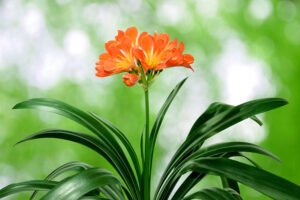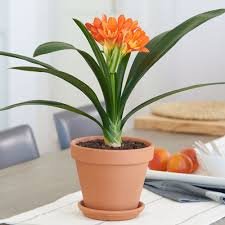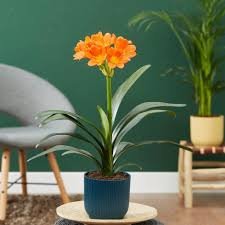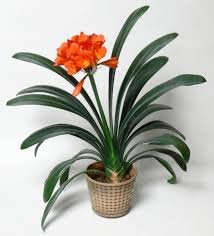Click Any Section to Learn More
Why Choose Clivia (Clivia miniata) for Indoors?
Clivia (Clivia miniata) is a standout choice for indoor plant lovers thanks to its ability to flourish in low-light conditions—perfect for rooms with minimal natural light. Its bold, trumpet-shaped flowers add vibrant bursts of orange or yellow, while its rich, dark green foliage delivers year-round elegance. Clivia is also remarkably low-maintenance and drought-tolerant, making it a worry-free addition to any interior space.
What Makes Clivia (Clivia miniata) So Attractive?

-
Striking Blooms: Bright, trumpet-shaped flowers in vivid orange or yellow hues.
-
Evergreen Foliage: Long, glossy, dark green leaves create a lush, tropical appearance.
-
Minimal Care Needs: Low-light tolerant and drought-resistant—ideal for beginners or busy lifestyles.
Special Capabilities of Clivia (Clivia miniata)
-
Thrives in Low Light: Perfect for shaded rooms or offices.
-
Water-Storing Roots: Thick, fleshy roots help retain moisture, supporting drought resistance.
-
Long-Lasting Blooms: Flower clusters can remain vibrant for several weeks indoors.
Psychological Benefits of Clivia (Clivia miniata)
-
Mood-Boosting Blooms: The vibrant color uplifts indoor atmospheres and reduces stress.
-
Low-Maintenance Peace: Easy care reduces anxiety and promotes a sense of accomplishment.
-
Mental Well-Being: Greenery indoors is linked to improved concentration and reduced mental fatigue.
Origin & Botanical Description
-
Native Habitat: Subtropical forest floors of South Africa.
-
Growth Habit: Clivia features arching, strap-like dark green leaves and produces tall flower stalks bearing clusters of vivid blooms—typically in late winter to early spring.
-
Evergreen Elegance: Maintains foliage year-round, adding lasting beauty to any room.
-
Display Ideas to Boost Interior Design
Leaf Cleaning Method
-
Wipe Gently: Use a soft, damp cloth to remove dust.
-
No Chemicals: Avoid leaf shine products or harsh cleaners.
-
Routine Matters: Regular cleaning supports healthy respiration and improved photosynthesis.
Special Care for Blooming

-
Cool Resting Period: In fall and early winter, keep Clivia in temperatures around 50–55°F (10–13°C) and reduce watering.
-
Light Requirements: Bright, indirect sunlight is ideal to trigger blooming—avoid direct exposure.
-
Post-Bloom Care: Return to moderate watering and maintain room temperatures to extend the bloom’s lifespan.
Recommended Pot Features
-
Material Options: Ceramic, clay, plastic, terracotta, metal.
-
Size: Use a shallow pot, slightly larger than the root system—Clivia prefers being root-bound.
-
Drainage: Ensure holes at the bottom; add a saucer to catch excess water.
Recommended Soil for Clivia (Clivia miniata)
-
Type: Peat-based mix with added perlite or sand for aeration.
-
pH Range: Slightly acidic (6.0–6.5) for optimal nutrient absorption.
-
Avoid: Heavy or compact soil that holds excess moisture.
Watering Tips for Clivia (Clivia miniata)
Tip Description
Frequency When top 1–2 inches of soil feel dry
Water Type Room temperature, non-chlorinated water
Caution Avoid overwatering—can cause root rot
Method Water thoroughly, allow excess to drain
Fertilizing Tips for Clivia (Clivia miniata)
Aspect Details
Types Use a balanced (20-20-20) liquid fertilizer or slow-release granules.
Frequency Apply every 4–6 weeks during spring and summer (active growth period).
Organic Options Compost tea, fish emulsion, or worm castings enrich the soil naturally.
Application Always fertilize after watering to avoid root burn. Never apply to dry soil.
Note: Do not fertilize during fall and winter when the plant is resting.
Ideal Indoor Environment for Clivia (Clivia miniata)
Condition Requirement
Air Circulation Avoid stagnant air; keep away from drafts and heating vents
Watering Let the top inch dry between waterings; never waterlog
Light Bright, indirect light (e.g., near a north or east-facing window)
Temperature Dormant: 50–55°F (10–13°C); Growing: 60–70°F (15–21°C)
Humidity Moderate indoor humidity is ideal; occasional misting in dry air
Note: Clivia (Clivia miniata) thrives best in cool to mild, temperate climates. The indoor conditions described above represent the minimum requirements for successful growth. If someone in a very cold or hot, arid climate wishes to decorate their home with Clivia, they should create the recommended indoor environment regardless of the weather outside.
Everything You Need to Know Before Repotting Clivia
Best Season
-
When to Repot: Spring, just after flowering.
-
Why: Allows Clivia to grow during its active season and prepare for next year’s bloom.
-
Avoid: Repotting during fall or winter, as the plant requires a dormant period.
Best Time of Day to Repot
-
Morning Repotting: Gives Clivia time to recover with ample light and airflow.
-
Benefit: Reduces risk of rot and transplant shock.
Required Tools for Repotting
Tool Use
New Pot Slightly larger than the root ball, with drainage
Potting Mix Well-draining mix with peat and perlite or sand
Watering Can / Spray Bottle Gentle watering post-repotting
Trowel / Small Shovel Transplanting and soil movement
Gloves Protects hands during the process
Newspaper / Plastic Sheet Keeps the area clean
Pruning Shears / Scissors Trim damaged leaves or roots
Watering Tray / Saucer Prevents water spills; allows bottom watering
Stake / Trellis Support for larger plants if needed
Soil Scoop Accurate soil transfer
Plant Labels Date tracking and identification
Root Rake Loosen root-bound plants gently
Mister Maintain humidity post-repot
Old Toothbrush Clean leaves and pot surfaces
Tweezers Remove debris from tight spaces
Propagation Methods
Propagation is done through division, usually after flowering. Here’s how:
Step-by-Step Guide:
-
Wait for Post-Bloom Period
➤ Best done in spring, after flowering has ended. -
Gently Remove the Plant
➤ Take Clivia out of its pot and gently shake off the soil to expose roots. -
Separate Offsets (Pups)
➤ Look for small side shoots with roots. Gently separate them from the main plant using a sterilized knife if needed. -
Pot Each Division
➤ Plant each pup in its own pot filled with well-draining soil. -
Water Lightly
➤ Keep the soil lightly moist and place the pot in bright, indirect light. -
Avoid Fertilizing Immediately
➤ Wait about 4–6 weeks before feeding the newly potted divisions.
Simple Ways to Keep Your Plant Looking Its Best (Pruning & Ongoing Maintenance)
Keeping your Clivia vibrant and healthy doesn’t require complex care—just a few simple habits go a long way.
Pruning Tips

-
Remove Dead or Yellow Leaves
➤ Gently trim aging or discolored leaves at the base to maintain a clean appearance and prevent disease. -
Cut Spent Flower Stalks
➤ Once blooms fade, trim the flower stalk down to the base to redirect energy to foliage and root growth. -
Avoid Over-Pruning
➤ Only remove what’s necessary—Clivia grows slowly, and excessive pruning can hinder development.
Regular Maintenance
-
Wipe the Leaves
➤ Use a soft, damp cloth to remove dust and enhance the plant’s ability to photosynthesize. -
Rotate the Pot
➤ Give your Clivia equal light exposure on all sides by rotating the pot every 1–2 weeks. -
Watch for Crowding
➤ If your plant becomes pot-bound, consider repotting after flowering season to prevent root stress. -
Monitor for Pests or Mold
➤ Regularly inspect foliage and soil for signs of mealybugs, fungus, or rot—early detection is key.
Pest Control and Prevention
Common Pest Control Method
Mealybugs Wipe with alcohol-dipped cotton swab or use insecticidal soap.
Scale Insects Remove manually and treat with neem oil or horticultural oil.
Aphids Spray with water or insecticidal soap; isolate affected plants.
Fungus Gnats Allow soil to dry between waterings; use sticky traps or beneficial nematodes.
Spider Mites Mist regularly to increase humidity; apply neem oil or soap spray if needed.
Common Diseases and Remedies
Common Disease Signs Remedy
Root Rot Yellowing leaves, mushy or black roots, foul smell Repot in fresh, well-draining soil. Trim off rotted roots and reduce watering.
Leaf Spot Brown or black spots, sometimes with yellow halos Remove affected leaves, avoid wetting foliage, and apply a mild fungicide.
Botrytis (Gray Mold) Gray, fuzzy mold on leaves or flower stems Improve air circulation, remove infected parts, reduce humidity.
Crown Rot Base of plant becomes mushy or collapses Stop watering, cut away damaged parts, and repot in dry soil.
Powdery Mildew White, powdery coating on leaves Increase ventilation, avoid leaf misting, and apply sulfur-based fungicide.
Common Mistakes to Avoid with Clivia (Clivia miniata)
Even though Clivia is a hardy and low-maintenance houseplant, certain care missteps can hinder its growth or blooming potential. Avoid these common pitfalls to keep your plant healthy and thriving:
1. Overwatering: Clivia is drought-tolerant and prefers to dry slightly between waterings. Too much water can cause root rot or fungal issues.
Tip: Water only when the top inch of soil feels dry.
2. Ignoring Dormancy: Clivia needs a cool, dry resting period in late fall to encourage blooming in spring. Skipping this dormancy phase often results in no flowers.
Tip: Reduce watering and keep the plant in a cooler room (50–55°F / 10–13°C) for 6–8 weeks.
3. Using Oversized Pots: Clivia prefers to be slightly root-bound. Repotting into a pot that’s too large can slow growth and delay blooming.
Tip: Choose a pot just slightly larger than the root ball.
4. Exposing to Direct Sunlight: Harsh direct sunlight can scorch Clivia’s broad leaves.
Tip: Place the plant in bright, indirect light or near an east- or north-facing window.
5. Frequent Fertilizing in Winter: Feeding Clivia during its dormant phase can damage roots and prevent flowering.
Tip: Pause fertilization during fall and resume in early spring.
6. Neglecting Pests and Dust: Dust buildup and occasional pest infestations (like mealybugs) can block light absorption and reduce plant vigor.
Tip: Wipe leaves monthly and inspect regularly for pests.
How Fast Does Clivia (Clivia miniata) Grow?
Clivia (Clivia miniata) is a slow-growing plant, typically producing one new set of leaves per year and taking 2 to 5 years to reach flowering maturity from seed. With optimal indoor care, such as proper light, watering, and rest periods, growth remains steady but gradual.
How to Tell if Your Clivia (Clivia miniata) is Healthy

You can identify a healthy Clivia by observing the following signs:
-
Vibrant, Dark Green Leaves: Healthy leaves should be firm, upright, and deep green without yellowing or browning edges.
-
Firm, Upright Growth: The plant should have a compact, symmetrical shape with no signs of drooping or wilting.
-
No Spots or Pests: Leaves should be free of dark spots, sticky residue, or visible pests like mealybugs or scale.
-
Strong Root System: When repotting, healthy roots will be thick, white, and firm—not mushy or discolored.
-
Seasonal Flowering: A mature Clivia will typically bloom once a year (usually in late winter or early spring) if given a proper cool rest period.
Tip: Regularly inspect your Clivia for changes in leaf color, texture, and posture to catch any potential problems early.
Final Thoughts
Clivia (Clivia miniata) is a timeless indoor favorite, offering elegance, color, and resilience. With its ability to thrive in low-light conditions and minimal water, it’s an excellent choice for both novice and experienced plant lovers alike.
Bring effortless elegance into your home—Clivia brings beauty that blooms with ease.

